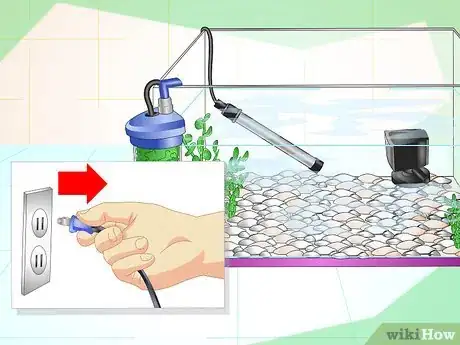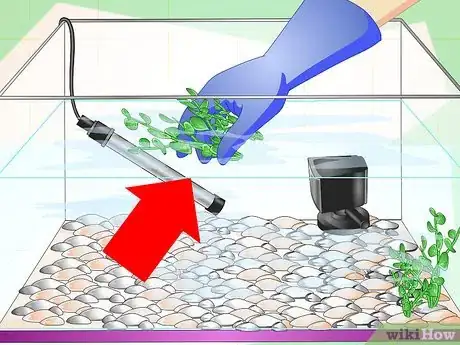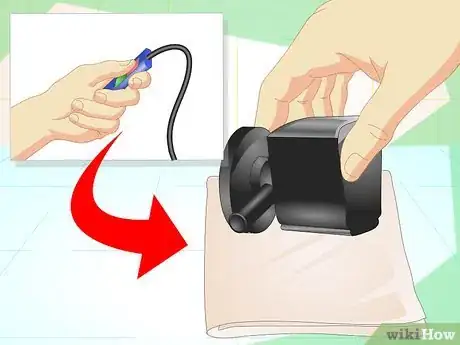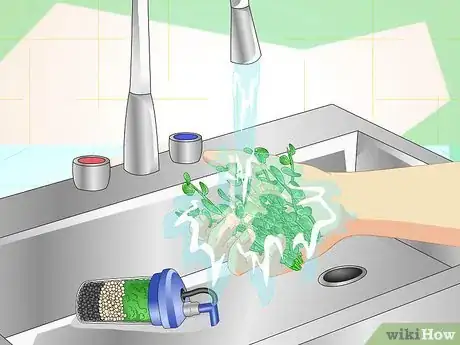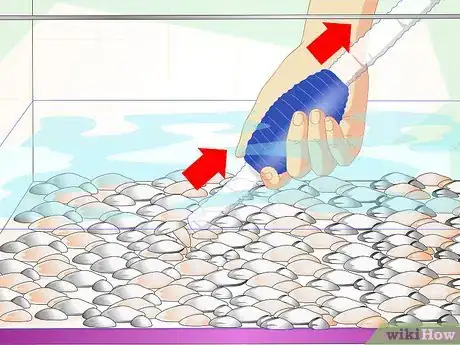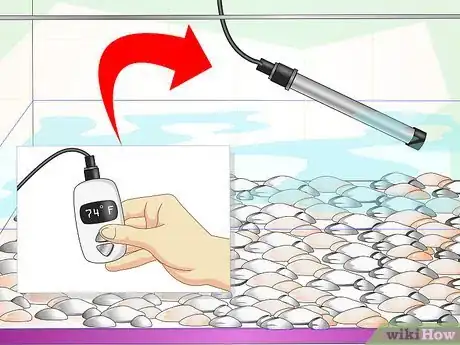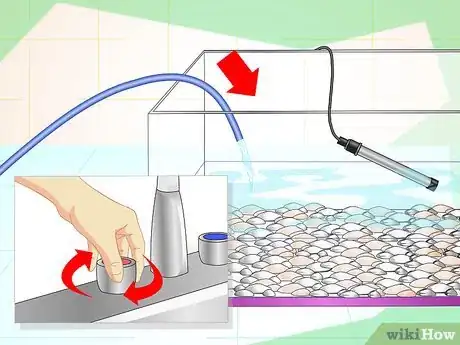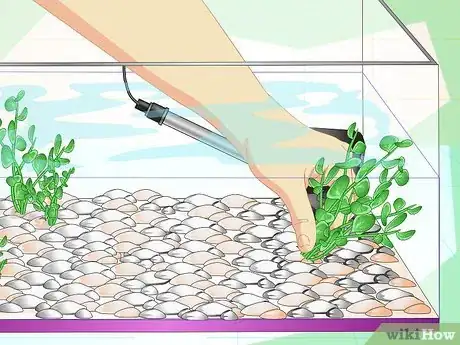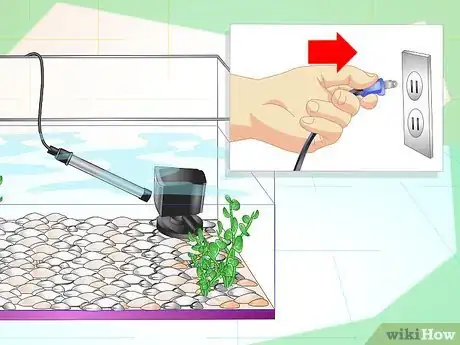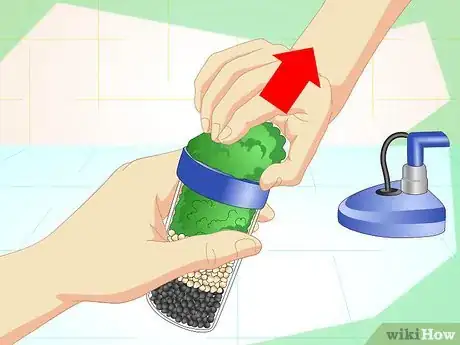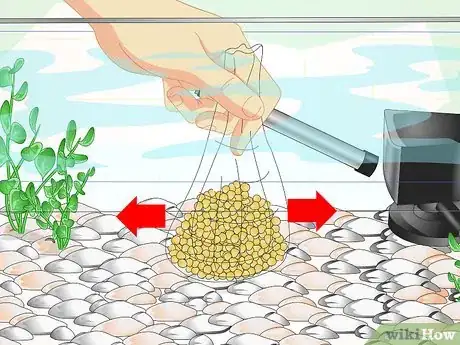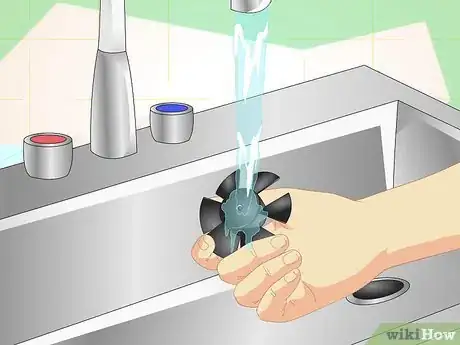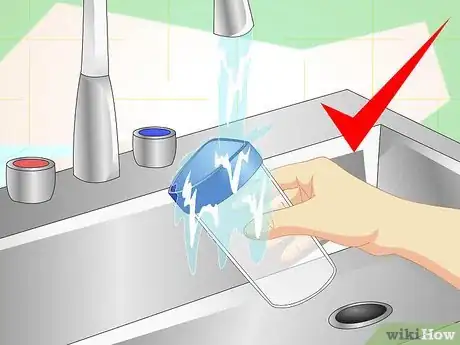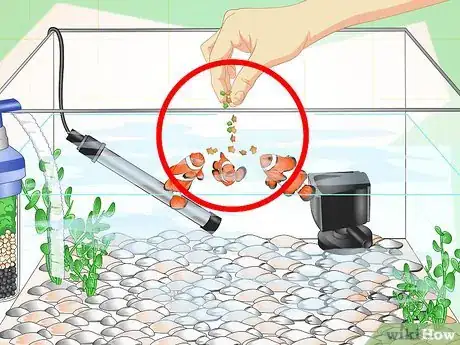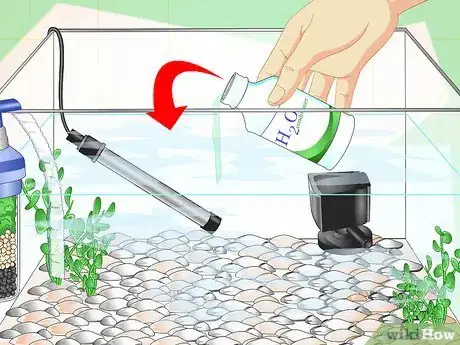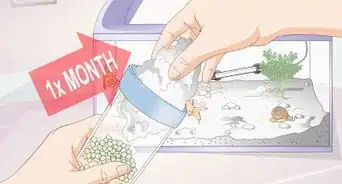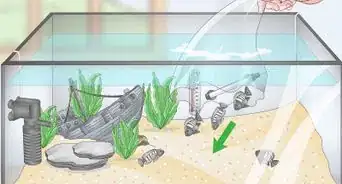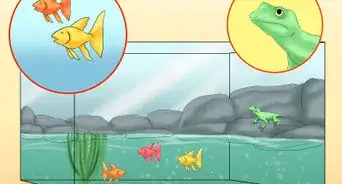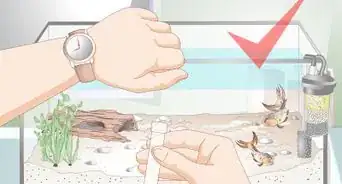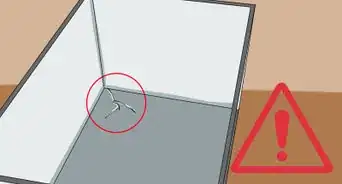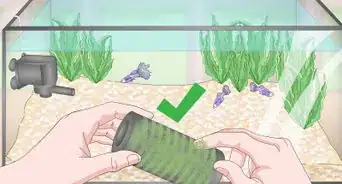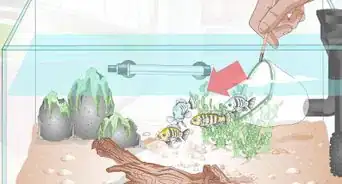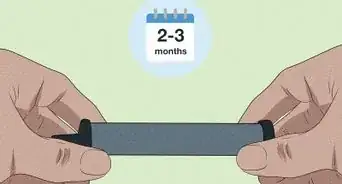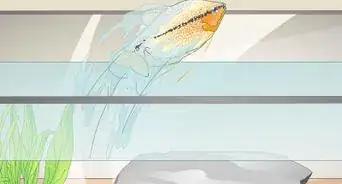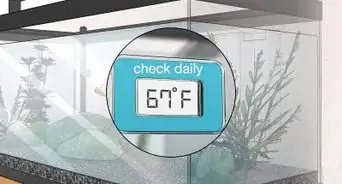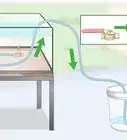This article was co-authored by Pippa Elliott, MRCVS. Dr. Elliott, BVMS, MRCVS is a veterinarian with over 30 years of experience in veterinary surgery and companion animal practice. She graduated from the University of Glasgow in 1987 with a degree in veterinary medicine and surgery. She has worked at the same animal clinic in her hometown for over 20 years.
There are 7 references cited in this article, which can be found at the bottom of the page.
This article has been viewed 304,160 times.
Cloudy aquarium water can have a number of culprits including faulty filters letting bacteria through, discharge from the fish, fish food, chemical additives to the water, and byproducts from decorations in the tank. Solving this problem involves dealing with the source, and cleansing the environment.
Steps
Changing the Aquarium Water
-
1Unplug the aquarium heater. Disconnect any other power sources for the tank as well so there is no risk of electric shock while you perform maintenance on the tank. But don’t remove the electrical devices yet.[1]
-
2Remove all decorations, and fake plants. Wear rubber, water proof gloves for this. Take out any objects from within the tank. Put them aside on clean paper towels.[2]Advertisement
-
3Scrub all sides of the aquarium. Do this with an algae sponge. Use deep, kneading like strokes for each inner surface. Make at least two or three passes each on the bottom and sides.[3]
-
4Turn off the pump. Slide the filter out of its position in the tank and set it aside on clean paper towels near a wash basin or sink along with the decorations you removed earlier.[4]
-
5Clean the filter, decorations, and fake plants. Run the filter, decorations, and fake plants under warm water. Rinse off each thoroughly with water to ensure no excess grime remains. Put the objects back on clean paper towels.[5]
-
6Connect a siphon gravel cleaner. This is usually a composite material tube with a siphon connected to a faucet or bucket to collect the extracted water. Push the gravel cleaner end into the bottom of the aquarium’s gravel layer until it reaches the bottom. Debris will rise through the siphon with the gravel and water. Once the water starts to clear, you should close the hose’s valve or pinch the hose above the gravel to allow the rocks to fall back down. Pull the gravel cleaner up, and put it back down to an adjacent area to repeat the process.[6] [7]
- Do this until approximately a quarter or one third of the water has been removed from the tank.
-
7Adjust the water temperature. Measure the temperature reading in the tank. Use a thermometer safe for water. You might ask the pet store for one for aquariums. Use the thermometer to adjust the water out of your tap to match the water temperature already in the tank.[8] [9]
- This step is more about not stressing the fish with sudden changes. Fish species can vary with the temperature they require, but a normal range to aim for would be 74-82º F (23-28º C).
-
8Switch the faucet pump to run water into the tank. You can also manually fill a bucket to restore water levels in the aquarium to normal. Add any chemical treatments, such as de-chlorinator, while the tank is filling. If you’re using the bucket-method, then add the treatments to the water before pouring the water into the tank.
-
9Place the decorations, fake plants, and filter back into the tank. Put the decorations and fake plants in first. Put these in more or less the same position you had them previously. Slide the filter back into its proper slot.[10]
-
10Plug in the heater, and start the pump. Reconnect the electrical systems of the tank once your hands are removed and thoroughly dry. Turn on the pump.
Maintaining the Filter and Equipment
-
1Clean or replace a mechanical canister filter. Use a screwdriver or similar tool to unfasten the top of the filter, and gain access to the sponge or pad. Remove the sponge or pad and rinse it under warm water for a few minutes. Alternatively, you can use the cleansed water from an aquarium water change session as the rinse water to retain healthy bacteria, and prevent ammonia contamination. If the sponge or pad is too full of debris, then you should purchase a replacement and install it into the filter. Once the original or new sponge/pad are back inside the filter, re-fasten the top and screw it back into place.[11]
- These filters needed cleaning at least every other week, but may need it more often if you have more fish.
-
2Treat with a chemical filter. Chemical filters usually take the form of granules or pellets. The chemical filter is normally placed sequentially after an existing mechanical filter and the water—or between the mechanical filter, and biological filter. Follow the instructions on the product you select, but normally, you will simply pour the instructed amount of granules into the filter, or pre-fabricated filter bag for placing in the tank water directly. A form of activated carbon is typical choice in this case. Activated carbon absorbs organic particles, medications, bacteria causing odors, and colors dissolved into the aquarium water. When the water is becoming cloudy, or smells bad, it is time to change the chemical filter.[12]
- Usually, these filters are good for 1-2 months. If you use a filter bag, then put the bag in a high water-flow area of the tank.
-
3Rinse the biological filter. The biological filter holds the bacteria that participates in the breakdown of material in the nitrogen cycle. This is a major step in keeping the water clear of ammonia, and nitrates—toxins that are eventually fatal to fish. These filters usually have a large surface area, and are located sequentially after the chemical filter. In other words, the water will filter through the mechanical and chemical filters first. If the biological filter is clogged, then you need to pull the filter, and rinse it only with the aquarium water in order to retain the helpful bacteria and slime on the surface.[13]
- You should only have to replace the biological filter if it’s physically damaged.
-
4Clean the impeller. For any motorized equipment, such as a pump or power filter, you need to follow your manufacturer’s instructions to maintain them properly. However, you can do some basic maintenance to make sure the water stays clean with well-run equipment. Do these power equipment cleanings during water changes while power is off, and disconnected from the tank. Use your instruction manual for removing impeller blades (motor blades) from power filters and pumps. Use a clean dust cloth to wipe debris from the impeller blades, and inspect it for damage. Replace it if damaged.
-
5Clean the filter housing. With the filter removed during a water change, you can take a few extra steps in maintaining it. Rinse the filter’s main housing, pipes (intake and outlet), and use aquarium safe lubricants for any moving parts. Petroleum jelly or liquid silicone can be useful as lubricants. Externally mounted power pumps may need machine oil, but consult your manual. After cleaning and lubricating the filter, you should put the pieces back together and reinsert the filter in the tank.[14]
- You may need to prime the filter before it will work again. Fill the filter with some of the aquarium water after insertion back into the tank. This will restart the siphon function.
Treating the Source
-
1Feed the fish less. Fish only need light feedings once a day, and should skip feedings one or two days per week. Remove uneaten food after 10 minutes.[15]
-
2Add aquarium salt to the water. Aquarium salt is essentially ordinary table salt (NaCl) with no additives. Add 1 tablespoon (15 milliliters) of aquarium salt for every 5 gallons (19 liters) of aquarium water.[16]
- Ask your veterinarian or pet shop owner if the fish species you own will tolerate aquarium salt.
-
3Add a water conditioner. This is a chemical product to eliminate chlorine, chloramine, ammonia, and nitrates from cloudy water more directly. This will work in both fresh water, and salt water environments. Instructions will vary with product, but you will pour this directly into the aquarium water at the rate of approximately .01 gallons (50 milliliters) of product for every 50 gallons (189 liters) of aquarium water.[17] [18]
- Add this during water changes too.
Warnings
- Don't introduce your fish to replacement or new water without putting them in a bag and letting it float on the new water, so the temperatures match. Rapid temperature change can kill the fish!⧼thumbs_response⧽
- Treat the new water with dechlorinator!⧼thumbs_response⧽
References
- ↑ http://www.peteducation.com/article.cfm?c=16+2154&aid=2649
- ↑ http://www.peteducation.com/article.cfm?c=16+2154&aid=2649
- ↑ http://www.peteducation.com/article.cfm?c=16+2154&aid=2649
- ↑ http://www.peteducation.com/article.cfm?c=16+2154&aid=2649
- ↑ http://www.peteducation.com/article.cfm?c=16+2154&aid=2649
- ↑ http://www.peteducation.com/article.cfm?c=16+2154&aid=2649
- ↑ http://www.amazon.com/Python-Pro-Clean-Gravel-Washer-Aquarium/dp/B001V6Y3LY
- ↑ http://www.peteducation.com/article.cfm?c=16+2154&aid=2649
- ↑ http://pets.petsmart.com/content/fish/aquarium-water-care.shtml
- ↑ http://www.peteducation.com/article.cfm?c=16+2154&aid=2649
- ↑ http://www.peteducation.com/article.cfm?c=16+2148&aid=2749
- ↑ http://www.peteducation.com/article.cfm?c=16+2148&aid=2749
- ↑ http://www.peteducation.com/article.cfm?c=16+2148&aid=2749
- ↑ http://www.peteducation.com/article.cfm?c=16+2148&aid=2749
- ↑ http://aquariumfish.net/information/cloudy_water.htm
- ↑ http://aquariumfish.net/information/aquarium_salt.htm
- ↑ http://aquariumfish.net/information/cloudy_water.htm
- ↑ http://www.amazon.com/fish-water-treatment/b/ref=dp_bc_3?ie=UTF8&node=2975478011
About This Article
To fix cloudy aquarium water, try replacing the water in the aquarium and cleaning the inside of the tank, the substrate, and any decorations. You can also try cleaning or replacing the filter and seeing if that helps clean the water. To prevent cloudy water in the first place, consider feeding your fish less, and always remove uneaten food after 10 minutes so it doesn't dirty the water. You can also add a water conditioner to eliminate chlorine, ammonia, and other things that cause cloudy water. For more tips from our Veterinary co-author, like how to use aquarium salt to fix cloudy water, read on!
